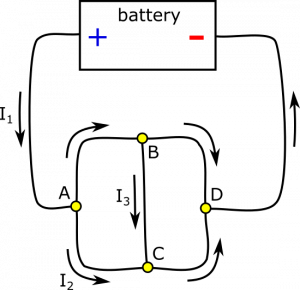This is an old revision of the document!
Looking at a Capacitor as it's Charging
Suppose you have a parallel plate capacitor that is disconnected from any power source and is discharged. At time $t=0$, the capacitor is connected to a battery. Make qualitative graphs of current ($I$) in the wire, charge ($Q$) on the positive plate, and voltage ($\Delta V$) across the capacitor over time.
Facts
- The capacitor is discharged.
- The capacitor is made up of parallel plates.
- The capacitor is connected to a power source at $t=0$.
Lacking
- Graphs of $I$, $Q$, $\Delta V$$.
Approximations & Assumptions
- The power source is connected correctly with respect to the capacitor and there are no other circuit elements (except for the wire).
- The wire itself has a small resistance, just so we do not have infinite current at $t=0$.
- Practically speaking, the capacitor becomes “fully charged” (with respect to the potential of the battery) at some finite time.
Representations
- We represent the setup below. The capacitor is pictured both disconnected and hooked up to the power source.
Solution
Let's start with node $A$. Incoming current is $I_1$, and outgoing current is $I_2$. How do we decide if $I_{A\rightarrow B}$ is incoming or outgoing? We need to bring it back to the Node Rule: $I_{in}=I_{out}$. Since $I_1=8 \text{ A}$ and $I_2=3 \text{ A}$, we need $I_{A\rightarrow B}$ to be outgoing to balance. To satisfy the Node Rule, we set $$I_{A\rightarrow B} = I_{out}-I_2 = I_{in}-I_2 = I_1-I_2 = 5 \text{ A}$$
We do a similar analysis for node $B$. Incoming current is $I_{A\rightarrow B}$, and outgoing current is $I_3$. Since $I_{A\rightarrow B}=5 \text{ A}$ and $I_3=4 \text{ A}$, we need $I_{B\rightarrow D}$ to be outgoing to balance. To satisfy the Node Rule, we set $$I_{B\rightarrow D} = I_{out}-I_3 = I_{in}-I_3 = I_{A\rightarrow B}-I_3 = 1 \text{ A}$$
For node $C$, incoming current is $I_2$ and $I_3$. There is no outgoing current defined yet! $I_{C\rightarrow D}$ must be outgoing to balance. To satisfy the Node Rule, we set $$I_{C\rightarrow D} = I_{out} = I_{in} = I_2+I_3 = 7 \text{ A}$$
Lastly, we look at node $D$. Incoming current is $I_{B\rightarrow D}$ and $I_{C\rightarrow D}$. Since there is no outgoing current defined yet, $I_{D\rightarrow battery}$ must be outgoing to balance. To satisfy the Node Rule, we set $$I_{D\rightarrow battery} = I_{out} = I_{in} = I_{B\rightarrow D}+I_{B\rightarrow D} = 8 \text{ A}$$
Notice that $I_{D\rightarrow battery}=I_1$. This will always be the case for currents going in and out of the battery (approximating a few things that are usually safe to approximate, such as a steady current). In fact, we could have treated the battery as another node in this example. Notice also that if you incorrectly reason about the direction of a current (incoming or outgoing), the calculation will give a negative number for the current. The Node Rule is self-correcting. A final diagram with directions is shown below.

